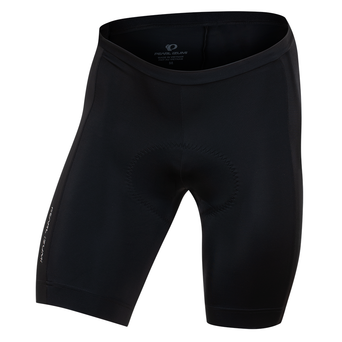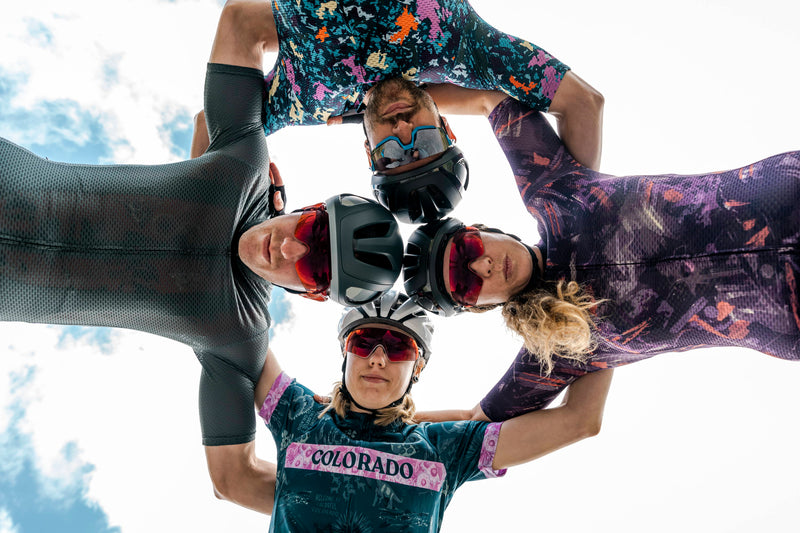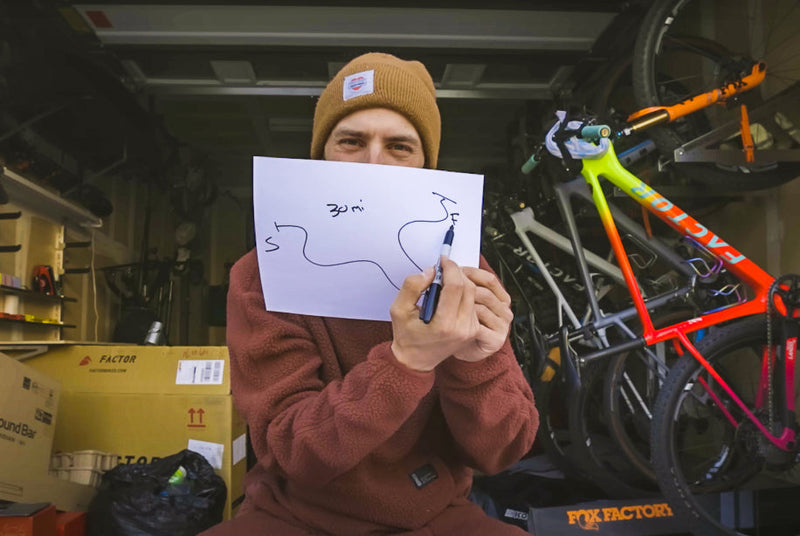As seems to be the case with many iconic, off-tarmac roads that cyclists enjoy today, the White Rim road was originally created for mining access. Carved, blasted, and cut by the Atomic Energy Commission in the 1950’s to facilitate uranium extraction during the Cold War, the White Rim Jeep Trail later became a sought-after riding (and OHV) objective, as mining operations had been, thankfully, abandoned when the area did not yield much uranium.
Situated in what is today Canyonlands National Park, the road itself is a 71-mile, point-to-point, that (in the counterclockwise direction) starts with a descent to Mineral Bottom then traces the Green River before climbing away at the beginning of Stillwater Canyon, all the while following the footprint of the Islands in the Sky mesa, before a final, punishing grunt up the Shafer climb. The route has been popularized as a 100-mile loop, commonly started at either the visitors center near the eastern boundary, or at the top of Mineral Bottom. The riding along the rim is raw, remote and wild. Sections of hard slickrock beneath coupled with the surrounding sandstone cliffs above, and canyon cuts below give the landscape a feeling that breaks the boundaries of our understanding of time. It only takes a vague comprehension of geologic forces to get the sense that this place delves further into Earth’s deep history than humans can fathom, and while this perception of geologic age applies to mountain ranges the world over, I find that sandstone formations—with their bared and obvious layers—convey this concept more readily to the eyes of amateur observers.

October 2019
My first exposure to the White Rim was in the form of a two-day, 140mi tour from Moab in October 2019, a year after getting into riding bikes seriously. I remember feeling the twin pulls of intimidation and awe as we plunged down Mineral Bottom to the Green River. As an east coaster, my first-ever trip to the desert came after graduating college, and I often still feel bowled over by its otherworldliness. Both the desert and the high alpine are two realms in which you can’t convince yourself that humans are the point—their respective inhospitable conditions are always a welcome perspective check.
On a rigid, dropbar set-up, the trip was memorably challenging in that it was some of the more relentlessly taxing riding I’d experienced to date, and, I still had a lot to learn in the ways of bikepacking (e.g. we ran out of food at 31mi of 78 in Day 2, and were out of water soon after, so much of that day was spent in a depleted bonk). However, I think that sometimes it’s the most challenging experiences that push us to want to come back better and stronger—and not just physically, but to return more mentally resilient to the inevitable challenges. At least, that was certainly the case for me and the White Rim. It was on this initial tour that I was both blown away at the notion of riding the stout loop in a day, and also resolved to come back to make it happen.


Spring 2022
Fast forward to March 2022—I’m turning 30. Unless you’re a snow sports person (and I’m a survival skier at best) an early March birthday usually doesn’t play that nicely with any grandiose outdoor objectives in Colorado, or much of the American West. And while I don’t think that every calendar milestone needs to be marked with a big outing, it does commit the occasion to memory when you can celebrate it with a momentous experience. For this occasion, I thought that finally returning to Moab for a White Rim in a Day (WRIAD) would be an appropriate and rewarding timestamp.
When a promising weather window around my decade-crossing weekend shifted to forecasted high winds and snow, we ended up pulling the plug on the desert trip. We still got out for a great day of pedaling at home in Boulder, but the canceled trip continued to eat at me, and I’d find myself keeping tabs on the Moab forecast, just in case.
About a month later, a forecasted perfect day in Moab presented itself that also happened to align with a few days of no commitments. One of the qualities I most value in my partner Tony is his gamely nonchalant attitude about making something happen on a whim—”let’s go, why not?!” In a funny twist of fate, he and Buzz Burrell—who was very likely the first to complete the WRIAD—are quite good friends and Buzz had previously offered his townhouse in Moab to us back in March. After (re)reaching out to Buzz to call in the rain check from our canceled trip, and doing some quick packing, we were off to the desert!
June 1985 – Buzz Burrell’s First WRIAD
It’s actually astonishing to think about how much has changed in cycling over the last 35-odd years in terms of the availability of information, and now having ridden the White Rim twice, it’s doubly astonishing to think about diving into it as an unknown quantity. When I asked Buzz about his first journey around the Rim, he had some pretty inspiring and entertaining details to share (per usual):
“I participated in the dawn of the mountain bike era: the first Pearl Pass Tour, first Moab Mountain Bike Weekend; I met Gary Fisher, Tom Ritchie and others in person. I’ve always maintained the WR is one of the Top Ten MTB routes in the world (I used to say it was the best, but I don’t know enough to confidently say that anymore). Not only because of its quality but because of its aesthetic purity: it is 100 miles —no route-finding, no shortcuts. Once you’re 50 miles in, you gotta ride 50 miles forward or 50 miles back!
The people riding bikes
I slept in the back of the car at the top of Mineral Bottom Rd and went counter-clockwise, and still maintain this is optimal, due to wind direction and topography…I was on a handmade Ritchie with a custom build assisted by Steve and Don Cook in Crested Butte. This bike would be worth a lot on E-Bay now, but I sold it in Lhasa, Tibet (another story). Pure blue with beautiful smooth fillets (welds) on the steel frame. Suspension hadn’t been invented yet, but the forks had a nice 2” curved rake which all bikes should have (reduces vibration)…Cinelli drop bars which we packed with wet sand (to avoid crimping) and carefully flared outward. Bar-end Sun Tour shifters…mafac cantilever brakes, 26-36-48 rings, with I think a 6-speed cassette (biggest there was). Another innovation was I used regular road pedals with toe clips and Sidi racing shoes, instead of the usual at that time Nike Lava Dome shoes on oversized platform pedals.
I still despise the MTB style of putting water on your back, which is top-heavy and loads your arms, and I carried three bottles road-style in frame cages. However, three bottles (20 oz each) was stupidly inadequate, and since these were flimsy aluminum cages, one bottle bounced out so I did the whole thing with 40 oz of water (finished very dehydrated).
The Ride: Went great, felt good, was a lot of fun, with the big/only problem being water. In the desert, there is always too much or not enough. “There are two easy ways to die in the desert – thirst and drowning” —Craig Childs. The Green

My WRIAD
Like Buzz, we car-camped the night before the ride. As we ate breakfast while getting the last things sorted on the bikes at the top of the Shafer climb, I was surprised at how chilly the morning was but reminded myself that the desert sun would be fierce enough later in the day. Just before rolling out of the lot, Tony asked, “Did you bring a pump?” Crickets. I had definitely assumed that he had the pump. Between the two of us, we had one CO2 cartridge—one shot if something went wrong with a tire. On the other hand, the route is now incredibly popular among multi-day riders with sag wagons, and jeepers down for the day. We decided to roll the dice and rely on the kindness of strangers if the ride went south.
We had opted to park at the visitors center at the top of the Shafer climb so we could bang out the pavement and long gravel stretch of Mineral Bottom Rd first—in the morning this stretch feels like fast, free miles, but I can imagine at the end of the loop it could feel like long, monotonous tedium. Dropping down Mineral Bottom, I noted that I didn’t have the same degree of intimidation as my first trip, now 2.5 years ago. Instead, I was just ready to get onto the good stuff!
My bike of choice for the day was my titanium Bearclaw Hardtail MTB, though setup fully rigid with a Whisky fork as supply chain issues had delayed the arrival of the suspension fork I’d ordered back in December. Oh well! With 2.8” rubber underneath, I felt like I had enough cushion and flotation, and compared to our previous trip when I’d been on dropbars, my flat bars today felt like a huge handling improvement. We were carrying a filter but with 4.5L of water strapped to my bike (similar amount on Tony’s) and a lot of cattle land and pesticides upstream, I hoped we wouldn’t need to use it.


We passed our first party on the first sandy sweep on the tail end of the Mineral Bottom descent. I sheepishly begged an extra CO2 off of them and the guy who gave it to me said, “Now that you have it, you’re sure not to need it.” Fortunately, his words proved prophetic but the extra peace of mind was relieving in the present.
The sandiness of the Potato Bottom section, the lowest point of the route, felt notable—lots of fishtailing and near front wheel nose dives. Once we began the climb away from the river—up Hard Scrabble and the ensuring rollers beyond—the sand, fortunately, lessened.



We stopped for lunch about 50mi in, at the same spot we’d camped at on our past tour. When tackling personal goals, I find that some days I feel almost too keyed up about the mission, and others are infused with a softer, quieter contentment. I’m not sure if it was the perfect, balmy weather, the stillness of the landscape, or simply being afforded the luxury of just focusing on the one task at hand after months of always juggling multiple side-hustles, but this day the tone was definitely more of the latter. I didn’t feel rushed—I was just happy to be out riding.
Murphy’s hogback—an iconic punch, preceded by the longest sustained climbing on the route—came about 8mi after lunch, and our drivetrains creaked desperately all the way up. Tony, who was on his fourth trip around the Rim, had confirmed my suspicions that conditions did indeed seem sandier than past outings. Murphy’s marks a distinct change in tone in the route, and in our direction, served as the gateway to many slickrock-heavy miles. There are also a few sections of prolonged, gradual descents in this half of the loop—those fast miles were definitely a morale boost as the afternoon grew later!

Cresting a short saddle around mile 70 revealed views of the La Sal mountains that we would have for most of the remaining miles. That tableau—with the red and beige of the desert topped by the snow-capped peaks under the blue sky—carried me through to the base of the Shafer climb.
We reached Shafer near dusk and there was nothing to do but put our heads down and grind it out. Unless they’re quite short, you can’t see the full extent of most climbs, but with Shafer you get to see all the switchbacks before you literally looming overhead. Turns out it wasn’t as soul-sucking as I’d thought it would be, in part because the light was doing its end-of-day magic show and as we rounded the last turn, we looked back to find the La Sals perfectly framed by the canyon’s walls in the forefront, with the road we’d ridden ribboning through the scene below. What a place!



We made it back to the car just as the evening had become fully dark. With lots of tired and contented sighs, we changed clothes and packed up the bikes before the drive into town to grab food and crash at Buzz’s. Some routes stand the test of time—and even if they become a bucket list route or a box to be checked, the experience of riding them mile for mile is anything but a tidy check mark. Nearly 40 years after Buzz’s first lap around the White Rim and it still delivers on adventure and beauty and challenge. And I imagine it will continue doing so for all the riders who flock to its grounds for years to come.




